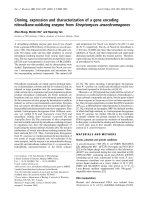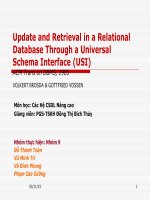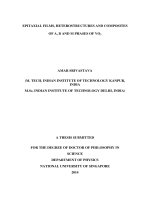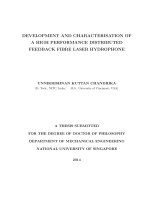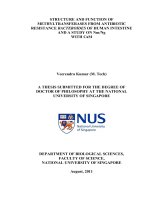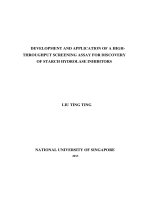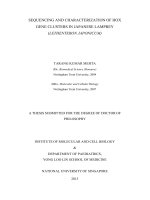Anatomy and Function of a Gene: Dissection Through Mutation
Bạn đang xem bản rút gọn của tài liệu. Xem và tải ngay bản đầy đủ của tài liệu tại đây (3.94 MB, 56 trang )
Chapter 7: Anatomy and Function
of a Gene: Dissection Through
Mutation
Chapter 7 of the textbook: Genetics:
From Genes to Genomes, 4th edition
(2011), Hartwell H. et. al.
CHAPTER OUTLINE:
7.1 Mutations: Primary Tools of Genetic Analysis
7.2 What Mutations Tell Us About Gene Structure
7.3 What Mutations Tell Us About Gene Function
7.4 A Comprehensive Example: Mutations That Affect Vision
1
VNU-University of Science - DNThai
7.1 Mutations: Primary tools of
genetic analysis
• Mutations are heritable changes in DNA base
sequences
• Forward mutation – changes wild-type allele to a
different allele
– e.g. A+ a or b+ B
• Reverse mutation (reversion) – changes a mutant
allele back to wild type
– e.g. a A+ or B b+
• Forward mutation rate is usually greater than
reversion rate
VNU-University of Science - DNThai
2
Classification of mutations by effect
on DNA molecule
• Substitution – replacement of a base by another base
– Transition – purine replaced by another purine, or
pyrimidine replaced by another pyrimidine
– Transversion – purine replaced by a pyrimidine, or
pyrimidine replaced by a purine
• Deletion – block of 1 or more bp lost from DNA
• Insertion – block of 1 or more bp added to DNA
• Inversion – 180° rotation of a segment of DNA
• Reciprocal translocation – parts of two
nonhomologous chromosomes change places
VNU-University of Science - DNThai
3
Mutations classified by their effect on DNA
Fig. 7.2 a-c
VNU-University of Science - DNThai
4
Mutations classified by their effect on
DNA (2)
Fig. 7.2d
VNU-University of Science - DNThai
5
Mutations classified by their effect on
DNA (3)
Fig. 7.2e
VNU-University of Science - DNThai
6
Rates of spontaneous mutation
• Mutant mouse coat colors:
albino
VNU-University of Science - DNThai
brown
7
Rates of spontaneous mutation
• Rates of recessive forward mutations at five coat color genes in
mice
– 11 mutations per gene every 106 gametes
• Mutation rates in other organisms
– 2 to 12 mutations per gene every 106 gametes
Fig. 7.3b
VNU-University of Science - DNThai
8
General observations of mutation rates
• Mutations affecting phenotype occur very rarely.
• Different genes mutate at different rates.
• Rate of forward mutation is almost always higher than
rate of reverse mutation.
• Average mutation rate in gamete-producing eukaryotes is
higher than that of prokaryotes
– Many cell divisions take place between zygote
formation and meiosis in germ cells (More chance to
accumulate mutations)
• Can diploid organisms tolerate more mutations than
haploid organisms?
VNU-University of Science - DNThai
9
Experimental evidence that mutations
in bacteria occur spontaneously
• S. Luria and M. Delbrück (1943) − fluctuation test
• Examined origin of bacterial resistance to phage infection
• Infected wild-type bacteria with phage
• Majority of cells die, but a few cells can grow and divide
– Had the cells altered biochemically?
– Did the cells carry heritable mutations for resistance?
– Did the mutations arise by chance or did they arise in
response to the phage?
VNU-University of Science - DNThai
10
The Luria-Delbrück fluctuation experiment
• Hypothesis 1: If resistance arises only after exposure to a
bactericide, all bacterial cultures of equal size should produce
roughly the same number of resistant colonies.
• Hypothesis 2: If random mutations conferring resistance arise
before exposure to bactericide, the number of resistant
colonies in different cultures should vary (fluctuate) widely.
VNU-University of Science - DNThai
11
The Luria-Delbrück fluctuation experiment
(cont)
• However, actual results showing large fluctuations suggest that
mutations in bacteria occur as spontaneous mistakes
independent of exposure to a selective agent (Hypothesis 2)
VNU-University of Science - DNThai
12
Replica plating verifies that bacterial
resistanceis the result of preexisting mutations
Fig. 7.5 a
VNU-University of Science - DNThai
13
Replica plating verifies that bacterial
resistanceis the result of preexisting mutations
Fig. 7.5 b
VNU-University of Science - DNThai
14
Interpretation of Luria-Delbruck fluctuation
experiment and replica plating
• Bacterial resistance arises from mutations that
occurred before exposure to bactericide
– Bactericide becomes a selective agent
– Kills nonresistant cells
– Allows survival of cells with pre-existing resistance
• Mutations occur as the result of random processes
– Once such random changes occur, they usually remain
stable
VNU-University of Science - DNThai
15
How natural processes can change
the information stored in DNA
• Hydrolysis of a purine base,
A or G occurs 1000 times an
hour in every cell.
VNU-University of Science - DNThai
• Deamination removes –NH2
group. Can change C to U,
inducing a substitution to and AT base pair after replication
Fig. 7.6 a, b
16
How natural processes can change
the information stored in DNA (2)
• C) X rays break
the DNA
backbone.
• d) UV light
produces
thymine
dimers.
VNU-University of Science - DNThai
Fig. 7.6 c, d
17
How natural processes can change
the information stored in DNA (3)
• Irradiation causes formation of free radicals (e.g. reactive
oxygen) that can alter individual bases
– 8-oxodG mispairs with A
– Normal G-C mutant T-A after replication
Fig. 7.6 e
VNU-University of Science - DNThai
18
Mistakes during DNA replication
Incorporation of incorrect bases by DNA polymerase is
exceedingly rare (< 10-9 in bacteria and humans)
Two ways that replication machinery minimizes mistakes
• Proofreading function of DNA polymerase (Fig 7.7)
3'-to-5' exonuclease recognizes and excises mismatches
• Methyl-directed mismatch repair (later in this chapter)
Corrects errors in newly replicated DNA
VNU-University of Science - DNThai
19
DNA polymerase’s proofreading function
Mispaired base is
recognized and excised by
3'-to-5' exonuclease of
DNA polymerase
Improves fidelity of
replication 100-fold
Fig. 7.7
VNU-University of Science - DNThai
20
Unequal crossing-over can occur
between homologous chromosomes
Pairing between homologs during meiosis can be out of register
Unequal crossing-over results in a deletion on one homolog and a
duplication on the other homolog
Fig. 7.8 a
VNU-University of Science - DNThai
21
Transposable elements (TEs) move
around the genome
TEs can "jump" into a gene and disrupt its function
Two mechanisms of TE movement (transposition)
Fig. 7.8b
VNU-University of Science - DNThai
22
Trinucleotide instability causes
mutations
• FMR-1 genes in unaffected people have fewer than 50 CGG
repeats.
• Unstable premutation alleles have between 50 and 200 repeats.
• Disease causing alleles have > 200 CGG repeats.
Fig. B(1) Genetics
and Society
VNU-University of Science - DNThai
23
Trinucleotide repeat in people with
fragile X syndrom
Fig. A, B(2) Genetics
and Society
VNU-University of Science - DNThai
24
Experimental evidence that mutagens
induce mutations
• H. J. Muller, an original member of Thomas Hunt Morgan’s
Drosophila group, first showed that: X-ray dose above the
naturally-occurring level causes increased mutation rate in
Drosophila
• Exposed male Drosophila to X-rays
• Mating scheme (see Fig 7.9) used genetically marked
"balancer" X chromosome
• Able to detect X-linked genes that are essential for viability
VNU-University of Science - DNThai
25


